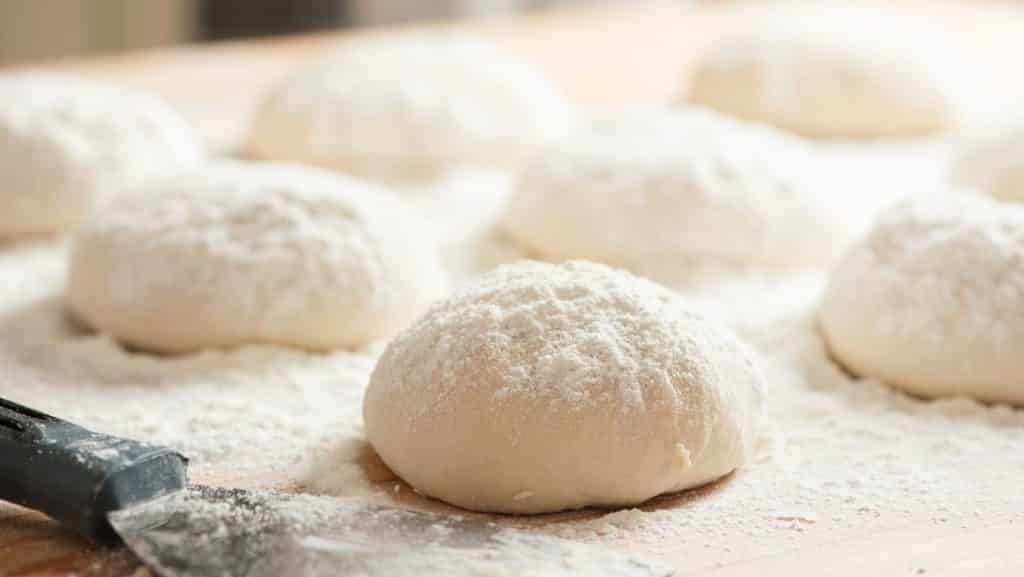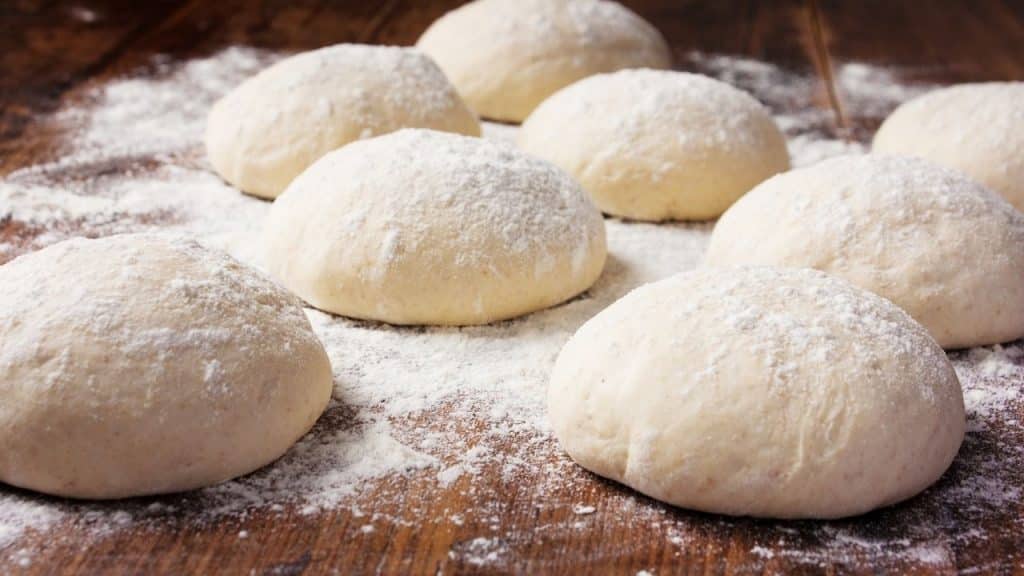
If you’re making pizza and the pizza dough is not rising, the end results are not going to be what your looking for.
The pizza is going to end up being dry and flat.
It can be so frustrating looking at your dough on the countertop and it just not getting any bigger.
Rising pizza dough is a science that few people are aware of. This article will explain what happens when your pizza dough rises, as well as the top reasons why it fails to rise.
The top reasons why your pizza dough not rising;
- It might be a result of too much water or just too old yeast.
- You’re raising the dough at a low temperature.
- You’re using too little yeast, which isn’t a good idea.
- You didn’t knead it enough.
- The dough must be allowed to rest for a longer period of time.
I’m going to explain what happens in the dough to make it rise. I’ll then share the most common reasons why your pizza dough is not rising.
What causes pizza dough to rise?
Fermentation, also known as rising, is a complicated procedure that is influenced by several factors.Essentially, yeast consumes sugars from the flour and converts them to carbon dioxide, which inflates the dough and causes it to expand.Let’s take a look at the four fundamental components that make up any pizza dough to better comprehend how this process works.
The 4 key ingredients for pizza dough
Pizza Dough only has 4 ingredients, but each are vital when it comes to helping the dough rise. The 4 ingredients are; flour, water, salt and yeast.
Yeast
Yeast are fungus that eat sugar. They make CO2 and alcohol as a result of the process. Yeast turns sugar into CO2 and alcohol – this is known as fermentation. The CO2 is what causes the dough to expand as it rises.
The yeast must be kept between a certain range of temperatures in order to function. When you make pizza, the yeast thrives at room temperature. The yeast will operate more quickly if it is warmer, and it will work more slowly if it is colder. The most important thing to control the speed at which the dough rises is the temperature or amount of yeast. Other factors, such as the dough’s hydration, the amount of salt, and the yeast’s quality, will also influence fermentation speed.
Flour
The flour is essentially food for the yeast, and during fermentation, the flour is broken down into sugars that the yeast feeds on. You want to feed your yeast good food, it’s therefore important to use quality pizza flour.
If you’re not sure if your dough has enough flour, just knead it. If it will not come together nicely and form a ball, then it needs more flour. Always add more flour to dough that is too sticky, there is not such thing at adding more water to a dough.
Water
Water allows the yeast to move more freely in the dough and consume its food (flour) faster. A higher hydration dough, therefore, enables the yeast to go even quicker and speed up fermentation.
The higher the water content, the more quickly the dough will rise. The lower the water content, on the other hand, the longer it will take for your pizza to rise.
Salt
Salt is not just a spice for pizza dough. The salt can help to regulate the yeast’s speed. As a result of this, if you add more salt to your dough, it will take longer to rise, and if you add less salt, it will speed up the process.
Salt is really important as it helps to enhance the flavour. Bread of any kind without salt is not nice to eat.
Do You Want Your Dough To Rise Quickly Or Slowly?

So it all comes down to this, you want your pizza dough to rise quickly or slowly? Well, this is up to you. If you want a faster fermentation process, then feed the yeast more sugar and warm them up! If you want the fermentation process to be slow then just let the yeast have some time for itself in a cool place.
You do need to consider the impact the rise has on the flavours of your pizza.
It is more than possible to have a pizza dough made and rise in just a couple of hours.
However…
The flavor of a slow-fermentation dough will be superior, as well as the consistency and digestibility. This takes time too perfect.
For a traditional Neapolitan pizza, a longer fermentation time to give it a good rise is going to give you the best results. 8-24 hours is ideal.
The reason your pizza dough not rising
So, now you hopefully know a bit more about how rising/fermentation works. Below are the most common reasons as to why your pizza dough not rising.
Dead Yeast
The yeast you used has died. This can happen if the yeast is past its expiry date or if the water was too hot.
If this happens, then there’s no need to tear your hair out. Just make a new batch and try again by feeding the yeast fresh sugar and checking the temperature of your water before adding it to your dough.
Bad Yeast
Yeast is a living thing and therefore does only have a limited shelf life. Fresh yeast will usually last 3 weeks. Dried yeast will last longer (12 months), however past this and it will go bad or if air has gotten to it then it also wont stay good for very long.
Check if the yeast is good
You do this by dissolving the yeast in a bit of lukewarm water and add a drop of honey to it and let it dissolve.
If after 10 minutes, there is no froth on top or if there is then it’s not fresh yeast anymore.
If it does have foam on the top then you know its good and you can use it and your dough should rise.
Not Enough Yeast
The amount of yeast used is something that many can get wrong. The more you have the quicker it will rise. So if you don’t have enough then it will naturally take longer.
This is how you can do fast rise doughs, as they tend to have a lot more yeast in them.
Its also worth noting that different types of yeast will require different amounts. for example if you was using fresh yeast, you would need a different amount compared to if you was using dried.
How much yeast do you need?
The amount of yeast you need is determined by two factors: the length of time your dough will rise, and the temperature at which you will bring it to a boil.
Based on our experience, a Neapolitan pizza should require no more than 0.2% yeast in the dough to be prepared properly. Because you want the process to go slowly and steadily. To achieve this slow rise, you would then leave it for 8-24 hours.
if your in a hurry with your homemade pizza then you might want it ready to be baked in 2 hours. For this short time, you would need around 5% yeast. You can still make a very nice pizza.
I would however recommend trying a slow-proofing dough. This really does give it a lot more depth and flavour. Plus its much easier to stretch and shape.
The amount of yeast you’ll require also depends on the temperature at which the dough is allowed to rise. So, if your home is colder than usual, you may need to use more yeast in the recipe. Similarly, if your home is excessively hot, you may need to reduce the quantity of yeast used in the recipe.
Too Much Salt
This can also prevent the yeast from rising, so it’s important to be careful when you add salt to your pizza dough. You don’t need to add a lot – just enough to enhance the flavors of the other ingredients without affecting the rise.
Water Too Hot
Because yeast is a living microorganism, it can perish if exposed to excessively high temperatures. Typical water that is 120-140°F (50-60°C), will be too hot and will kill the yeast. Your dough wont rise if it’s in water that is too hot.
Water Too Cold
Now the same can be said with cold water, although it wont kill the yeast it will slow it down.
The yeast will resume working after the dough has warmed up, but not until it reaches a certain temperature. As a result, if you begin with cold water, the dough will take longer to rise than if you start with room temperature or lukewarm water.
One thing to bear in mind is that the dough’s temperature rises when it is kneaded. As a result, using water that is cool rather than hot may not be a terrible idea.
In fact, when it comes to baking Neapolitan pizza, the AVPN (The True Neapolitan Pizza Association) recommends using water that is 68°F (20°C). The reason for this is that it will allow the dough to attain its ideal rising temperature once you’ve finished kneading.
Water Quality
In low temperatures, you’ll need to adjust your tap water. Fermentation will be slowed by bad water. The quality of tap water varies depending on where you live. Hardness, pH, and various chemicals all influence fermentation duration. If you’re not sure about the quality of your tap water, try using bottled instead.
Cold Room Temperature
Another reason your pizza dough isn’t rising is that the space you’re fermenting it in is too chilly. The yeast will be slowed down at colder temperatures. Even if you start with hot water, it will cool if you leave the dough to rise in a cold room.
Too Short Rising Time
This is why your pizza dough didn’t rise. You must give it enough time. This is especially important if you are making Neapolitan-style pizza.
Dough Hasn’t Been Kneaded Enough
When you knead your pizza dough, gluten develops which is very important.
Gluten development, which happens when you knead the dough is also important for the dough to rise. Because yeast converts sugar to CO2, the gas must be contained in order for the dough to rise. That’s where gluten comes into play.
Gluten is a protein that may be found in wheat flour. Gluten strands will grow in strength when you hydrate and knead it. When you knead the dough, you’re building a stronger network all around. The CO2 is trapped in this web of tiny barriers and increased dough volume. When the dough is fermenting, it’s similar to what happens when you fill a balloon with gas: the yeast is filling it with gas.
If you don’t knead the dough long enough, the gluten network will be insufficient to retain gas. The yeast will produce the gas as fast as it can, and the leak will just keep getting worse. Consider attempting to inflate a balloon with holders; it won’t go well.
Ideally you want to knead the dough for long enough for the gluten to develop.
Usually Ill knead for between 5-10 minutes.
How to fix pizza dough that is not rising?

Now you know the reasons why your pizza dough wont rise. Lets have a look at what we can do to fix it.
Increase The Temperature
If your dough isn’t rising, the first thing to check is the temperature where it’s fermenting. If you need a warmer environment for your dough, you could try putting your dough in the oven and placing a bowl of boiling water.
The heat will circulate and be trapped in the oven, helping it to rise.
An easier way would be to adjust the amount of yeast you need, based on the temperature. You can use a dough calculator to work out how much you would need.
Check that your yeast is alive
When you’re making Neapolitan-style pizza, as is the case with most bread recipes, you don’t leave the yeast in lukewarm water to rehydrate. As a result, it’s more difficult to tell whether your yeast is operating properly.
The way you can see if its still alive does change, depending on the type of yeast you’re using.
Fresh yeast is usually obvious and detectable. The outside of old yeast becomes dry and/or discoloured. It will also start to smell if its not fresh. If you see any of these, then I personally wouldnt use it.
To check if the dry yeast is still active requires a couple more steps. You need to actually get it working to see. Although you dont want to be wasting time making dough to find out that it is not active.
Get some yeast and some lukwarm water. Add a spoon of sugar or honey and mix everything together. Leave this for 5 minutes and you should start to see it develop. It should start to smell and form foam on the top of the water.
Add More Yeast To Your Pizza Dough
Depending on the type of yeast you use, if it’s not working try adding more. If I am using active dry yeast and it is not rising, ill add some more to a little warm water and add it to the dough.
Remember that adding water will affect the hydration of your pizza dough. So you may need to add more flour to get the right consistency.
Knead the pizza dough more
You must knead the flour for at least 5-10 minutes in order to develop the gluten sufficiently. If the dough is smooth and when you poke it, the dough bounces back then its good to get using.
If you poke it and it stays down then you need to carry on kneading the dough for a bit longer.
Give It More Time
Sometimes all that is needed is a little more time. I can be very impatient. Try moving it to a slightly warmer place of the house and give it an extra hour.
Is your Environment The Reason Why Your Pizza Dough Is Not Rising?
Another point to consider is that, depending on the temperature and humidity in the room, your dough may rise differently. Temperature, humidity, and altitude are some of the most common factors that influence rising. So, if you’re following a dough and it doesn’t seem to produce the same results in your kitchen, it’s possible that you live in a different climate.
Temperature
In higher temperatures, the dough rises more quickly, so if you live in a hot climate, it will grow faster than if you reside in a cold climate (unless you use a heater or air conditioner to regulate the temperature). Because the yeast is more sensitive to heat, less of it should be used in a hot environment, and more of it should be used in a cold one.
Humidity
In a more humid environment, the dough will rise faster. If you’re baking in a high humidity location, your dough will be more hydrated than if you were to bake the same recipe in a low humidity location. It is also due to the fact that the dough will absorb moisture from the air, resulting in a higher hydration. As previously stated, greater hydration will result in longer rising time, but lesser hydration will cause it to rise quicker. Given that the outside temperature is high, you may need to alter the water content in your dough depending on the humidity level.
Altitude
Due to the reduced air pressure, higher altitudes result in dough rising faster. The dough can rise up to 50% faster at 3000 feet (900m) than it does at sea level. If you’re using a yeast starter, the best thing to do is reduce the amount of yeast. You should decrease the amount of yeast by approximately 20% at 3000 feet.
Making Pizza Whilst Travelling
You need to remember the above if you are travelling or making pizza dough in different locations.
I often go camping with the pizza oven and sometimes I make dough around the tent in the morning. I have to remember that the temperature outside the tent will be alot colder than in the kitchen at home.
At the same time, the temperature inside the tent will be a lot higher. There is also less humidity inside the tent. So its often worth keeping these things in mind when making your dough.
Final Thoughts
Pizza dough doesn’t always rise the way we want it to. In order to figure out why, you have a few options: more yeast, longer kneading time, warmer environment or different climate/altitude. With these tips in mind and some tweaking of your pizza dough recipe, you may be able to bake a perfectly risen pizza next time!
Sources







